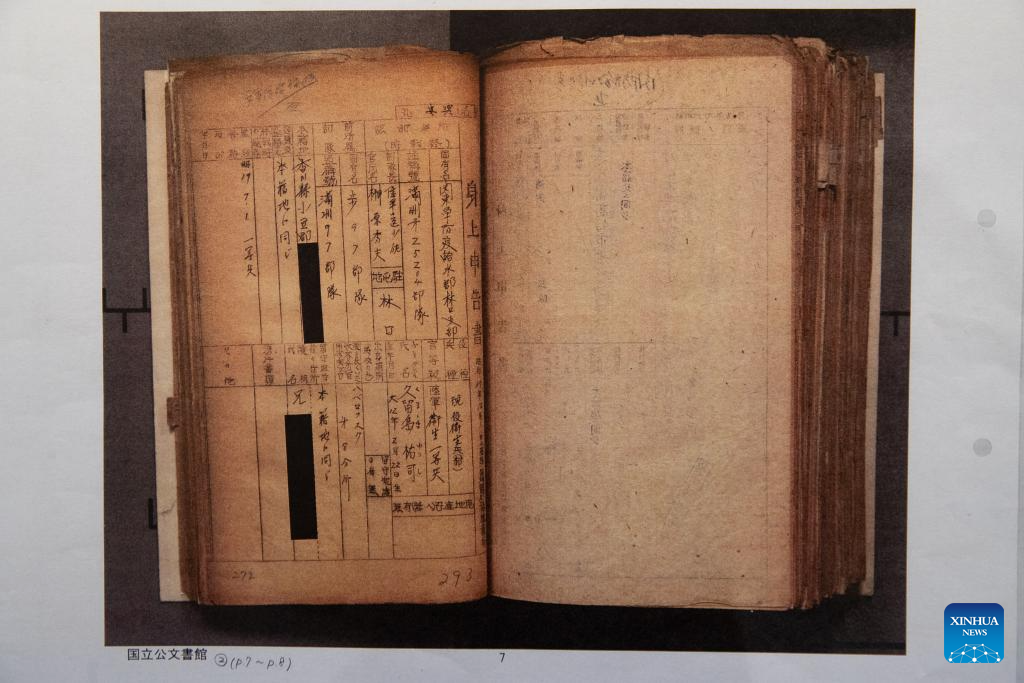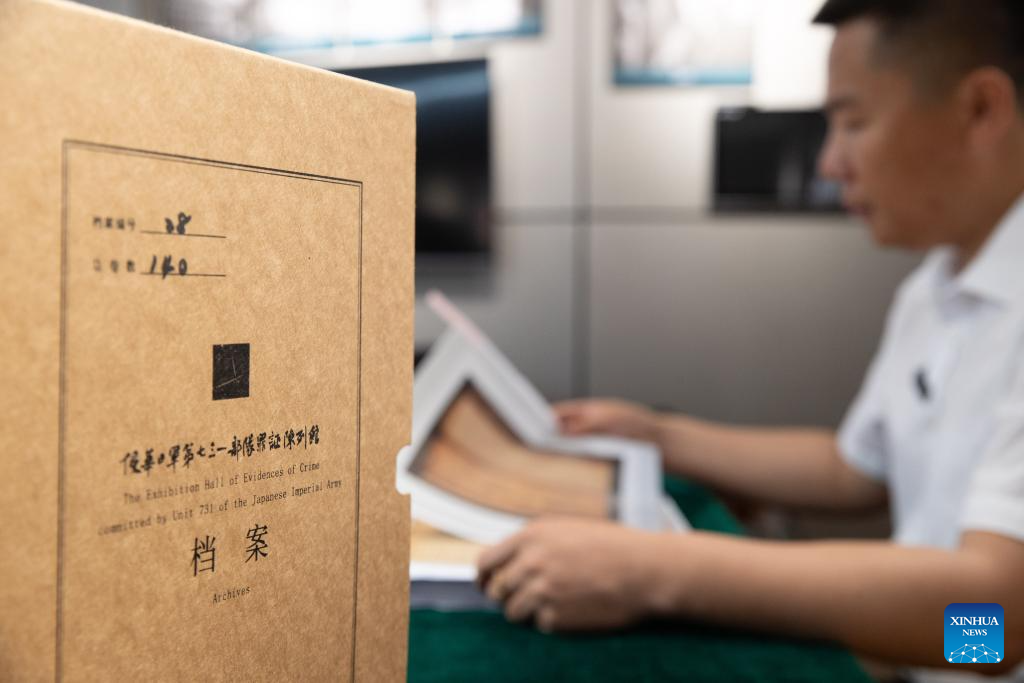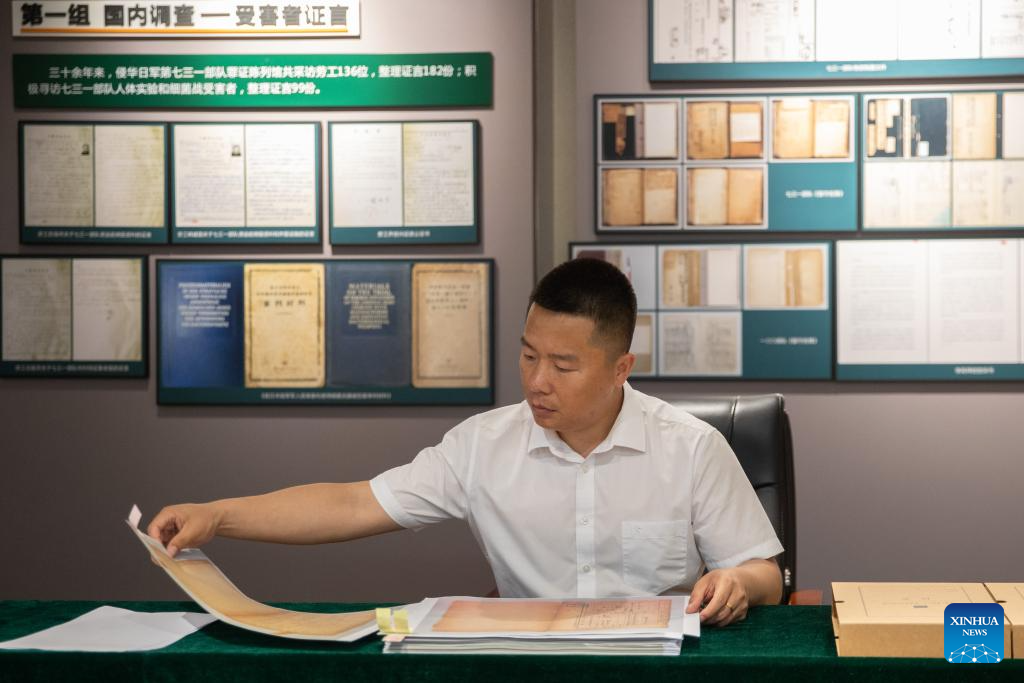
Jin Shicheng, a researcher with the Exhibition Hall of Evidences of Crime Committed by Unit 731 of the Japanese Imperial Army, displays a photocopy of Japanese military personnel registration forms detailing their work in Unit 731, a Japanese germ-warfare unit during World War II, in Harbin, northeast China's Heilongjiang Province, July 5, 2024. A total of 177 pages of Japanese military personnel registration forms detailing their work in Unit 731, a Japanese germ-warfare unit during World War II, were made public in Harbin, the capital of northeast China's Heilongjiang Province, on Saturday. (Xinhua/Zhang Tao)
HARBIN, July 6 (Xinhua) -- A total of 177 pages of Japanese military personnel registration forms detailing their work in Unit 731, a Japanese germ-warfare unit during World War II, were made public in Harbin, the capital of northeast China's Heilongjiang Province, on Saturday.
The forms contain the personal information of 140 members of the unit, including doctors, lieutenants, medical soldiers, military employees and others, who belonged to the Linkou Division, the biggest of the four divisions set up by Unit 731 on Dec. 2, 1940. It is also known as the 162nd Manchurian Unit.
According to Jin Shicheng, a researcher with the Exhibition Hall of Evidences of Crime Committed by Unit 731 of the Japanese Imperial Army, the documents show that the work of these people covered bacterial experiments and production, laboratory-animal feeding, education and training, health and epidemic prevention, and so on.
In one of the forms, the Japanese military personnel are shown conducting rat-catching operations in Heilongjiang's Jiamusi and other places, which further proves the role of Unit 731 in plague-related experiments.
Unit 731 was a top-secret biological and chemical warfare research base established in Harbin as the nerve center for Japanese biological warfare in China and Southeast Asia during World War II.
The victims, referred to in Japanese as "marutas", or wooden logs, were deliberately infected with typhus, typhoid, cholera, anthrax and plague, in addition to many other bacterial diseases, to serve the goal of perfecting biological weapons.
The forms also show the links between Unit 731 and other units. For instance, some soldiers were recruited under the names of other units, and were transferred to the Linkou Division after receiving three months of training in Unit 731.
"This shows the deception of Unit 731, which recruited in the name of infantry as a disguise for its war crimes," Jin said.
Experts believe that the forms provide key evidence for a comprehensive understanding of the composition of the Linkou Division, their transfer during the war, as well as their post-war activities, and are of great significance for expanding the academic understanding and research perspectives of the Unit 731 issue. The new evidence once again proves that the Japanese invasion of China was a top-down, large-scale and organized state crime.
The files were found at the National Archives of Japan. Copies of the files were brought back to China in 2022 after negotiations and discussions. ■

This photo taken on July 5, 2024 shows a photocopy of Japanese military personnel registration forms detailing their work in Unit 731, a Japanese germ-warfare unit during World War II, at the Exhibition Hall of Evidences of Crime Committed by Unit 731 of the Japanese Imperial Army in Harbin, northeast China's Heilongjiang Province. A total of 177 pages of Japanese military personnel registration forms detailing their work in Unit 731, a Japanese germ-warfare unit during World War II, were made public in Harbin, the capital of northeast China's Heilongjiang Province, on Saturday. (Xinhua/Zhang Tao)

This photo taken on July 5, 2024 shows a photocopy of Japanese military personnel registration forms detailing their work in Unit 731, a Japanese germ-warfare unit during World War II, at the Exhibition Hall of Evidences of Crime Committed by Unit 731 of the Japanese Imperial Army in Harbin, northeast China's Heilongjiang Province. A total of 177 pages of Japanese military personnel registration forms detailing their work in Unit 731, a Japanese germ-warfare unit during World War II, were made public in Harbin, the capital of northeast China's Heilongjiang Province, on Saturday. (Xinhua/Zhang Tao)

Jin Shicheng, a researcher with the Exhibition Hall of Evidences of Crime Committed by Unit 731 of the Japanese Imperial Army, arranges a photocopy of Japanese military personnel registration forms detailing their work in Unit 731, a Japanese germ-warfare unit during World War II, in Harbin, northeast China's Heilongjiang Province, July 5, 2024. A total of 177 pages of Japanese military personnel registration forms detailing their work in Unit 731, a Japanese germ-warfare unit during World War II, were made public in Harbin, the capital of northeast China's Heilongjiang Province, on Saturday. (Xinhua/Zhang Tao)

Jin Shicheng, a researcher with the Exhibition Hall of Evidences of Crime Committed by Unit 731 of the Japanese Imperial Army, arranges a photocopy of Japanese military personnel registration forms detailing their work in Unit 731, a Japanese germ-warfare unit during World War II, in Harbin, northeast China's Heilongjiang Province, July 5, 2024. A total of 177 pages of Japanese military personnel registration forms detailing their work in Unit 731, a Japanese germ-warfare unit during World War II, were made public in Harbin, the capital of northeast China's Heilongjiang Province, on Saturday. (Xinhua/Zhang Tao)



